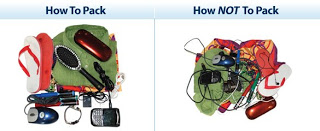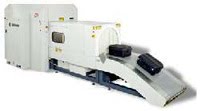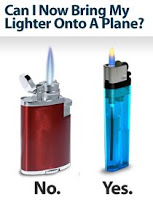Summertime isn’t officially here yet, but as far as I’m concerned, it’s summer as soon as the pools are open. So, in preparation for this holiday weekend and the summer travel season to come, I wanted to post some helpful travel tips. Our highly trained security officers are prepared for the increase in passenger volumes and are dedicated to ensuring safe travels. TSA will be fully staffed and prepared to address the needs of the traveling public this summer.
So lather up with your favorite suntan lotion, take your laptop out in the sun, and read all about TSA travel tips. Fruity beverages and lounge music are optional.
 How to Get Through the Line Faster
How to Get Through the Line Faster: Passengers can help speed up the screening process by packing their carry-ons in an organized manner. This helps our officers efficiently see what's inside to quickly process it through screening. We put together some great tips on how to get through our lines faster.
Click here to read tips about how to pack your bags, the right clothes to wear, which ID to use and many other helpful tips and videos. If you travel through an airport with
Advanced Imaging Technology (Body Scanner), ensure you remove everything from your pockets whether it’s metal or paper to prevent you from having to undergo additional screening.
Are You Going Camping This Summer?: Check out
this post for tips on traveling with your camping gear.
The 4-1-1 on 3-1-1 (Liquids, Gels & Aerosols): If you have liquids, aerosols, or gels that are used for medical or infant/toddler purposes, they do not need to adhere to our 3-1-1 policies and do not have to be placed in a bag. You may be asked to go through a TSA Family Lane (see below) so we can expedite the screening process. The liquids, gels and aerosols will need to be removed from your bags and declared to a TSO.
If you’re checking a bag, make it easy on yourself and just put your liquids in your checked luggage. That way, you don’t have to worry about 3-1-1. I know that suggestion doesn’t work for everybody. Some liquids are essential and some of you understandably would not like to pay to check your luggage. If you’d rather take liquids in your carry-on, please continue reading…
3-1-1 is the name for our liquid policy. You can read
here for more details, but here is the gist of 3-1-1… Each passenger is allowed to take one clear quart-sized sealable bag and fill it with as many liquids in 3.4 oz or less sized containers that will fit, while still being able to seal the bag. Basically, don’t stuff it to the point where it won’t close. Make sure you take the bag out of your carry-on prior to sending it through the X-ray, or our officers will have to search your bag.
Answers to common questions: Stick deodorant is not limited to 3.4 oz or less, but gel or spray deodorant is. Powder makeup is fine. Common size facial cosmetic and medicinal products in a tube, for example mascara, lip gloss, and lip balm are not required to be placed in the 1 qt. bag.
Family Lanes: Frequent flyers hate it when they’re in line behind a family, and guess what… families hate it when the frequent flyer is behind them tapping their foot and sighing. That’s why we created
Family Lanes. They’re designed to let families take their time and ask questions without feeling rushed by the experienced frequent flyers who can zip through a checkpoint in no time. Also, as stated earlier, anybody carrying exemptible liquids, aerosols and gels in excess of 3.4 oz may be directed to a Family Lane.
Foods: Food items that are in the form of a liquid or gel are generally not permitted however, items such as cakes, bread, donuts, ham sammiches, etc. are all permitted.
Here is a list of items that are prohibited at the checkpoint… Creamy dips and spreads (cheeses, peanut butter, salsa, jams and salad dressings, gravy (mmm gravy), jams, jellies, maple syrup, oils and vinegars, sauces, soups, wine, liquor and beer.
ID & Boarding Pass Checking & Secure Flight: As you approach a TSA checkpoint, you will see an officer checking IDs and boarding passes. Please have your
acceptable ID and boarding pass out and ready to present to our officer. If your ID is in a plastic sheath or other type of holder, it will need to be removed so our officers can properly inspect your IDs. By having your ID and boarding pass out and ready, you’ll help move the line along faster. The several seconds it takes to get your ID and boarding pass out might not seem like much time, but it really adds up when you’ve got people in line behind you.
Also, folks have had questions about the
Secure Flight program and whether the name on your ticket has to match the name on your ID. The Secure Flight watch-list matching process occurs before a passenger even gets to the airport so if you get a boarding pass, the Secure Flight watch-list matching process is done. In other words, you are clear once you get that pass.
If you have lost or forgotten your ID, you will still be permitted to fly as long as you help us verify you are who you say you are by answering a few questions for us. It will take some extra time, so please make sure you get to the airport earlier than you normally would.
Inconsistencies: You may notice your screening experience at one airport doesn’t match the experience of another airport. We realize this happens, and some of it is intentional. While it can be a little confusing for our passengers, it also makes things unpredictable for those who might wish to do us harm.
Here are some more links to tips for traveling with special items this summer:
The best piece of advice I could give a traveler is to arrive early. No matter what happens, (aside from a flight being cancelled) if you get to the airport early, you should be fine. Worst case scenario is you’ll have some time to catch up on some reading or a few Z’s while you wait on your flight.
Also, we’re going to be Tweeting a TSA Summer Travel Tip every day for the rest of the week, so follow us on Twitter @tsablogteam for travel tips, blog post announcements, and other useful information.
Make sure you check out our
Summer Travel Checklist. (PDF)
If you’re traveling internationally, be sure to check out U.S. Customs and Border Protection’s international travel tips.
Have a great summer!
Blogger Bob
TSA Blog Tteam








